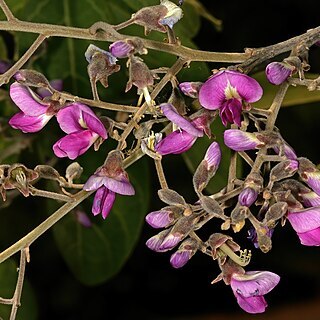A shrub or small tree. It grows 12 m tall. It is round at the top. The bark is rough and grey. The small branches are hairy. The leaves have one leaflet. It is leathery and stiff. They are 16 cm long by 9 cm wide. The flowering shoots are 30 cm long. The pod is narrow and 10 cm long by 2 cm wide. There are 1-4 seeds.
Standard patent-reflexed, c.12 mm long, blade subcircular, 10–11 mm in diameter, with prominent calluses at the base, glabrous on the back; wings 12.5–13.5 × 3.5–4 mm, obovate, auricle c.0.8 mm long, acute, claw 1.5 mm long; keel petals 12–12.5 × 5–7 mm, arcuate-cucullate, auricle acute, claw 1.5–3 mm long.
Calyx 4–6 mm long, upper tooth-pair c.2.5 mm long, retuse, the lateral ones 1–2 mm long, obtuse, the lower one 2.5–3 mm long, triangular-acute.
Pod 1–4-seeded, linear, up to 10 × 2 cm, rounded at the apex, cuneate at the base, stiff, thinly sericeous; stipe c.3 mm long.
Inflorescence up to 30 cm long, borne precociously in axils of fallen leaves, or terminal, yellowish-grey-tomentose.
Ovary 5–7-ovulate, 6 mm long, shortly stipitate, densely pilose; style 3 mm long, glabrous.
Tree or shrub up to 12 m tall; crown rounded or irregular; bark rough, grey to dark brown.
Branchlets pubescent, glabrescent or tomentose with bark red-brown, becoming blackish.
Flowers mauve to pinkish, 10–12 mm long.
Seed 12 × 9 × 2 mm, testa brown, smooth.


